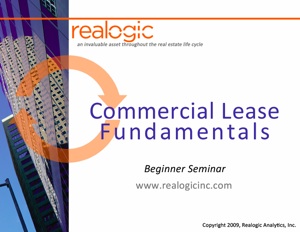Continuing our Commercial Lease Fundamentals series, today’s topic is a breakdown of the four components of a  commercial real estate lease.
commercial real estate lease.
Component 1: Basic Lease Information
Whenever I read a lease or a lease-related document, I like to think of myself as an investigative journalist or a private detective. My job is to put together the pieces of the story so I can summarize it, find out if the story being told lines up across all documents and identify (then highlight) any unusual situations. If I find language that might be a costly risk to the landlord or if the landlord is missing an opportunity for revenue, I want to know about it.
In terms of the first component of a lease, the Basic Lease Information is the classic journalist questions: Who, What, Where,When and Why. My next blog post in this series will focus on the details within the basic lease information.
Component 2: Rent
For those coming from residential lease reading, the concept of rent can seem to be pretty cut and dry. With commercial properties where rent is split between base rent and any number of different additional rents though, it can be anything but simple.
In this section, I’ll describe the way base rent is set, escalated or abated, affected by regional standards or adjusted by market conditions. In a separate post, I’ll explain additional rent concepts including payments based on a tenant’s pro rata share (including recovery mechanics) and other non-prorated additional rent amounts such as percentage rent and index adjustments.
Component 3: Options
The second half of the four components of a commercial lease are both descriptions of the legal rules, rights and responsibilities of the landlord and tenant. The parts of a lease that relate to either party’s right to exercise a change in the length of term or achange in size or location of leased space are called Options.
After we complete the first two components, I’ll describe the options most often seen in commercial leases including Termination Rights, Relocation Rights, Expansion Rights, Extension or Renewal Rights and possibly the most confusing aspect of lease options, the difference between Rights of First Refusal and Rights of First Offer.
Component 4: Clauses
The final component of a commercial real estate lease may sometimes be considered the least important but it contains the most detail to learn. Clauses are the rights and responsibilities of the landlord and tenant other than those covered by options. Things like a tenant’s right to audit the landlord’s additional rent calculations, a landlord’s right to recapture in the event of a tenant default, either party’s right to sublease or assign the lease, insurance requirements and much more.
This will be the last section covered by this blog series but will undoubtely last a while as lots of clauses deserve to be considered.
In closing, I hope that you, the reader, continue to follow this blog as we delve deeper into these Commercial Lease Fundamentals. Eventually, we’ll cover all of these topics and more, continuing again with the next post on November 6th, 2013.